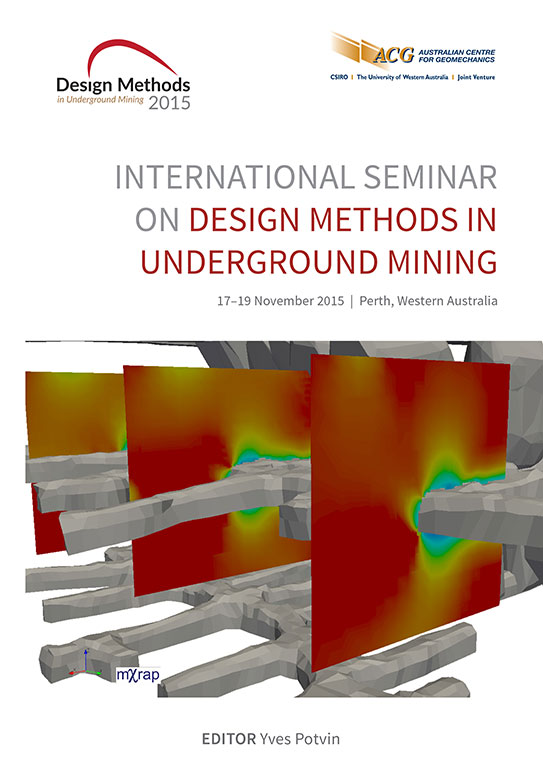Study of stress conditions at Williams Mine using underground observations and microseismic monitoring data

|
Authors: Earl, PJ; Malovichko, D; Rebuli, D |
DOI https://doi.org/10.36487/ACG_rep/1511_06_Earl
Cite As:
Earl, PJ, Malovichko, D & Rebuli, D 2015, 'Study of stress conditions at Williams Mine using underground observations and microseismic monitoring data', in Y Potvin (ed.), Design Methods 2015: Proceedings of the International Seminar on Design Methods in Underground Mining, Australian Centre for Geomechanics, Perth, pp. 149-163, https://doi.org/10.36487/ACG_rep/1511_06_Earl
Abstract:
The C Zone/Interlake orebody at Williams Mine, Ontario, Canada, is one of the Hemlo ore-bearing lodes. It is adjacent to the B Zone orebody, for which the stress state has been well studied, with evidence supported by underground observations. The extrapolation of stress conditions from B Zone to C Zone/Interlake seemed logical, thus common characteristics of in situ stress were previously used for design and planning purposes. Over time, a number of discrepancies were found between the assumed stress state and underground observations (damage of boreholes and orepasses) around the C Zone/Interlake orebody. An alternative model of in situ stress was considered for the C Zone/Interlake region. The induced stresses were evaluated for a mining sequence for both old and new models. The recorded seismic response to the modelled sequence was compared with the expected response in terms of location and source mechanisms of seismic events. The new model shows better agreement, increasing confidence in numerical stress models used for C Zone/Interlake mine planning.
References:
Bawden, WF 2006, February 2006 site review, Williams Operating Company & David Bell Mine, internal report, prepared for Barrick Gold, Kingston, Canada.
Coulson, A 2009, ‘Investigation of the pre to post peak strength state and behaviour or confined rock masses using mine induced microseismicity' PhD thesis, University of Toronto.
Kazakidis, VN 1990, ‘An integrated study of fractured rock mass behaviour using structural mapping, microseismic monitoring and numerical modelling’ Master of Science thesis, Queen's University.
Linkov, AM 2005, ‘Numerical modeling of seismic and aseismic events in geomechanics’, Journal of Mining Science, vol. 41, no. 1, pp. 14-26.
Linkov, AM 2013, ‘Numerical modelling of seismicity: theory and applications', in A Malovichko & D Malovichko (eds), Proceedings of the 8th International Symposium on Rockbursts and Seismicity in Mines, GS RAS & MI UB RAS, Obninsk-Perm, pp. 197218.
Malovichko, D & Basson, G 2014, ‘Simulation of mining induced seismicity using Salamon-Linkov method’, in M Hudyma & Y Potvin (eds), Proceedings of the 7th International Conference on Deep and High Stress Mining, Australian Centre for Geomechanics, Perth, pp. 667-680.
Malovichko, D & Lotter, E 2008, Moment tensor inversion for Jmts (using amplitudes & polarities), internal report, prepared for ISS International, Stellenbosch, South Africa.
Mendecki, AJ 1993, ‘Real time quantitative seismology in mines’, in P Young (ed.), Proceedings of the 3rd International Symposium on Rockbursts and Seismicity in Mines, Balkema, Rotterdam, pp. 287-295.
Muir, TL 1997, Precambrian geology, Hemlo Gold deposit area: volume 289 of Ontario Geological Survey report, Ontario Ministry of Northern Development and Mines, Ontario, Canada.
Salamon, MDG 1993, 'Some applications of geomechanical modelling in rockburst and related research', in P Young (ed.), Proceedings of the 3rd International Symposium on Rockbursts and Seismicity in Mines, Balkema, Rotterdam, pp. 297-309.
van Aswegen, G 1993, ‘Applications of quantitative seismology in South African gold mines’, in P Young (ed.), Proceedings of the 3rd International Symposium on Rockbursts and Seismicity in Mines, Balkema, Rotterdam, pp. 261-266.
© Copyright 2025, Australian Centre for Geomechanics (ACG), The University of Western Australia. All rights reserved.
View copyright/legal information
Please direct any queries or error reports to repository-acg@uwa.edu.au
View copyright/legal information
Please direct any queries or error reports to repository-acg@uwa.edu.au